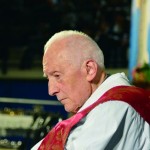Mary for Today – Part 3
The Second Millennium
Changing Times: Among the new factors emerging in the church of the second millennium was a growing legal system within church office, an increasingly severe penitential system, and an increasing remoteness from the risen Christ as a saving figure who was now turned into a stern and just judge. Eternal salvation was regarded as exceedingly difficult; the torments of hell could be avoided by recourse to Mary, a powerful help for sinners, for she was mother of the judge as well as mother to the sinner. As all this spun out, Mary became detached from the gospel story of salvation history.
With the High Middle Ages and the revival of European culture, by the 12th century devotion to Mary was widespread. Great cathedrals were built; St Bernard and the Cistercians expressed her glories through the time of the Crusades, the era of feudalism, and of courtly love. Social and historical developments had their influence on Marian doctrine and devotion. Terms from chivalry emerged as Mary was addressed as ‘Our Lady’ and ‘Madonna’, respectful titles given to feudal aristocrats. Mary, simple maiden of Nazareth, is made one of the aristocracy, the great Queen of Heaven, with a place above the church, between God and the highest angels.
From Mother to Mediator: What began as the understanding that Mary was the means by which God came to earth, the vehicle so to speak, of Christ’s saving presence in history, now becomes a mediation that functions in reverse to effect sinful humanity’s going back to God. The image that becomes popular was of Mary as the ‘neck’ connecting Christ with his body the church, and as the ‘aqueduct’ through which the graces of Christ flow. St. Bernard was to say that God ‘wills us to have everything through Mary’. Today, theologians have been made aware by Protestant criticism that in the undeveloped Catholic theology of the Holy Spirit, Mary had replaced the Holy Spirit as advocate, mediator, comforter, and bestower of graces. We are now called to give back to the Holy Spirit what belongs to the Holy Spirit and to Mary what belongs to Mary.
Consciousness of sin and fear of judgement were characteristics of this era. The awesome God the Father was seen as stern king and just judge, difficult to approach. Christ, too, was far removed from ordinary people as a distant feudal king. Divine mercy found its expression in the mother of Jesus, intercessor for those who sought her aid in pleading with her Son. Given the climate of fear, it is little wonder that devotion to Mary blossomed into a profusion of prayers, hymns, cathedrals, pilgrimages, poems, miracle stories, dramas, songs, images, and practices in an outpouring that is impossible to codify.
The Reformation and its Enduring Effects: In the 16th century, at the time of the Reformation, theology and piety were at a low ebb and Marian devotion was by turns sentimental and superstitious, a virgin beautiful but not sacred, or a powerful mother who promised salvation despite the lack of ethical living. Rene Laurentin, the French Mariologist, sums up the era as ‘repelled by a desiccated intellectualism, people sought life on the imaginative and sentimental plane. Throughout this period of decadence, popular enthusiasm for the Blessed Virgin never faltered, but the adulterated fodder it was nourished on consisted of trumpery miracles, ambiguous slogans, and inconsistent maunderings.” The Reformers’ criticism was largely justified, and Trent called for correction of abuse. But regarding Mary, Catholics developed a severe case of fixation, while Protestants developed a severe case of amnesia. Devotion to Mary became a badge of identity, and it was virtue to promote her glories.
The Reformers did not turn against Mary in herself. They rejected her veneration on Christological grounds. Luther, who wrote one of the best treatises on Mary’s prayer, the Magnificat, protested at what he saw as false honour done; in praying to Mary and asking for favours, it could be detracting from Christ as sole mediator between God and humanity (1 Tim 2:5). It is encouraging to see in our own times the widening acceptance of Mary in Protestant circles, especially her role in the Incarnation and the whole process of salvation. The loss of tenderness and a harsh, judgmental, and thoroughly masculine ecclesial emphasis is the price paid for the loss of Mary in any church!
From Then On: The end result was to cut off thought about Mary from the rest of theology, especially treatments of Christ, salvation, the Holy Spirit, and the Church. The late Fr. Pat Bearsley S.M., an internationally respected Mariologist, puts it very well as “we have a picture of a vigorous Mariology growing luxuriantly in an otherwise impoverished theological garden.” At this point we have an independent subject governed by a set of its own rules:
The rule of singularity (Mary is unique).
The rule of analogy (in her own way Mary parallels Christ in all things).
The rule of eminence (Mary surpasses other Christians in all things).
The rule of suitability (God could have, should have, and therefore did do great things for his mother. Duns Scotus).
Out of these rules results the view of Mary as the unique, immaculately conceived virgin mother of God par excellence, graced with perfect virtue, the totally obedient, humble handmaid who was also Queen of Heaven with power to intercede for our salvation, and who was assumed body and soul into heaven. But this pattern retains its fatal flaw, its isolation from theology, especially Christology, as a whole; Mariology had indeed gone off on its own track. It had lost touch with modern forms of thought, theology, and spirituality. However, filling a great need, it flourished.
Source: Elizabeth Johnson and Kathleen Coyle.
Next Month: Vatican II and Beyond.



 Entries(RSS)
Entries(RSS)